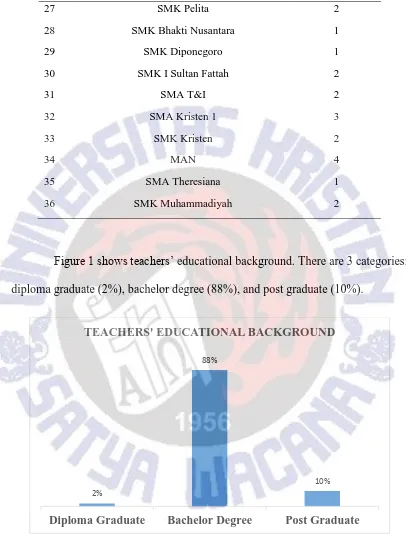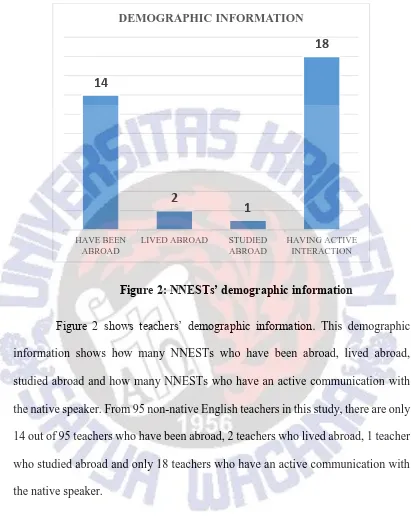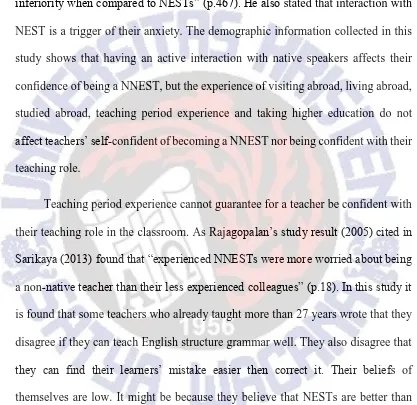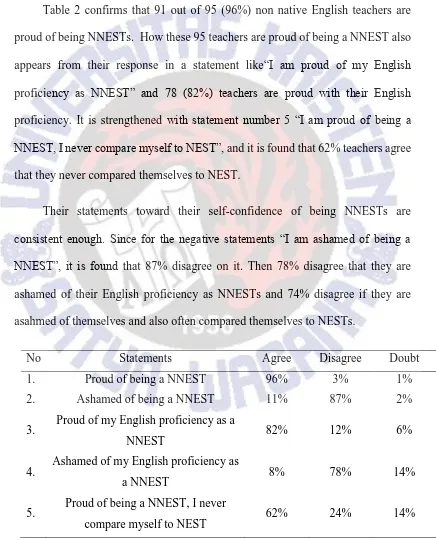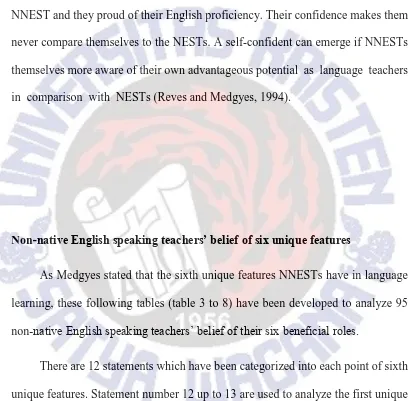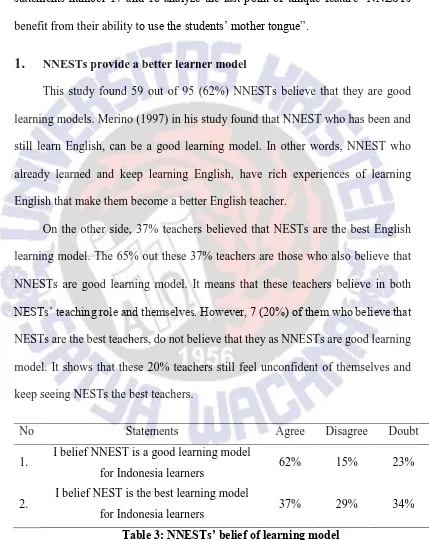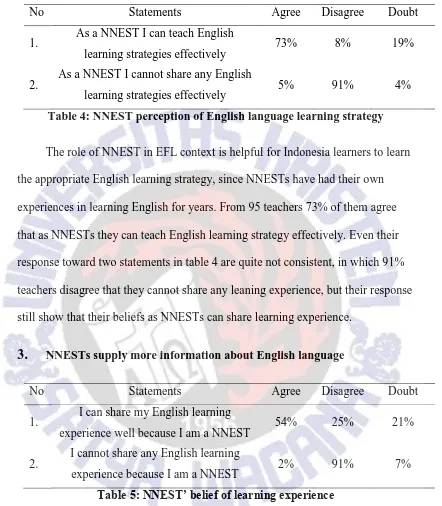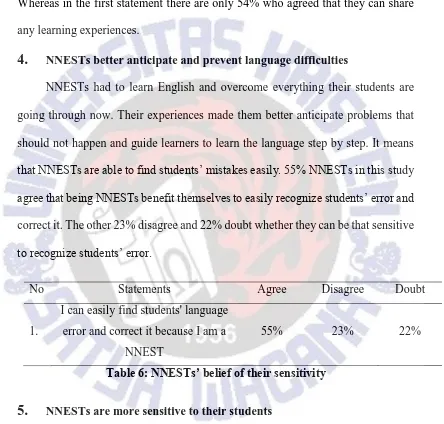NON-
NATIVE ENGLISH SPEAKING TEACHERS’ SELF
PERCEPTIONS OF BEING A NON-NATIVE ENGLISH
TEACHER
THESIS
Submitted in Partial Fulfillment
Of the Requirements for the Degree of
Sarjana Pendidikan
Karisma Manesia Oktavia
112013059
ENGLISH DEPARTEMENT
FACULTY OF LANGUAGE AND ART
UNIVERSITAS KRISTEN SATYA WACANA
INTRODUCTION
Many people think that NESTs are the best English speaker model because
of their natural language. However, there are many researchers revealed that
NNESTs are also good. There have been many studies conducted in countries with
EFL context which revealed the differences of NESTs with NNESTs, also their
advantages and disadvantages in language learning. Walkinshaw and Oanh (2014)
mentioned that NESTs are good at oral skills and knowledge of their own culture,
but they lack of ability to explain complex structure. Setiawan (2015) proposed that
“in Indonesia, the strong preference for NEST is prevalent; many English-speaking
course institutions and schools hire native speakers of English regardless of the
speakers’ education background” (p.6). NESTs are not only seen as the best English
speaker teachers, but they are also regarded as prestige symbols that can raise the
institutions’ status to attract more students. On the other side, Cook (2005) as cited
in Tajeddin and Adeh (2016) proposed that NNESTs can be good examples of
successful learners because they are competent learners of English. Solhi and
Rahimi (2013) affirmed that “The NNS EFL teacher is also able to find linguistic
problems and offer metacognitive learning strategies that the native teacher
without foreign language experience is unable to notice” (p.865). In addition,
Choi (2007) cited in Sarikaya (2013) claimed that:
However, Medgyes (2001) found in his study that the proportion of students
who choose NNEST is high, since NNESTs are in possession of some bright
features such as; providing a better learning model, more sensitive to language error
and students need, supplying more information about learning strategies and
English language and benefit from the use of mother tongue.
As English education student, I have experienced both problems with the
NESTs and NNESTs. There are distinct differences between the role of NESTs and
NNESTs. During the classroom learning, I found that NESTs are the best language
learning model of acquiring and applying the English language than NNEST. I
thought that NESTs are able to provide a real-world communication experience.
Somehow, NNESTs are better in delivering and transferring the lesson, since they
also use our mother tongue (Indonesian language in this context) to help us
comprehend the target language and language structure well. When my NNESTs
use their mother tongue to facilitate the language learning, I felt secure to learn
English as the foreign language. The use of mother tongue helped me to learn
English naturally. I also found that my NNESTs acted as facilitator and mentor.
They provided effective learning strategies and more information to learn English
better. I thought that having NNESTs in language learning classroom benefit the
students to learn English better.
Refer to my experience and some researchers which revealed the benefit
of having NNESTs in English language learning, this study is conducted to know
whether the NNESTs are aware of their beneficial role in learning English as the
value themselves as non-native English teacher in teaching English. Are they
confident of being a NNEST? Whether they are aware of their beneficial role in
language learning? The research question to be answered in this study is, “How do
NNESTs perceive themselves as a non-native English teacher?”
There are not many studies which focus on discussing NNESTs’ self
-perception of their role in EFL classroom context. This study seems to be significant
for NNESTs in EFL context to be aware of their beneficial role in English language
learning. It will be beneficial to motivate NNESTs to be self-confident of
themselves. I believe that NNESTs who have good self-confident and understand
their beneficial role for Indonesian students in learning English, would be more
enthusiastic and motivated to teach English and help students to acquire more
English naturally and easily.
How NESTs and NNESTs are differed
NESTs and NNESTs are the abbreviation of native English speaker
teachers and non-native English speaker teachers. There are various definitions of
NESTs and NNESTs. Sarikaya (2013) defined NESTs as teachers whose L1 is
English, whereas NNESTs are those whose L1 is not English. Hadla (2013) added
that NNESTs’ first language is their native language which is naturally acquired
from birth, and then English is their second or third language. Medgyes (2001)
defined NNESTs as a teacher whose English is a second language, who works in
EFL environment, whose students are monolingual learners and speak the same
language with their students. Medgyes (1994) also revealed the differences between
they are stricter, have more committment than NESTs and they also focus to
students’ real need. NESTs and NNESTs are also differed from their attitude in
teaching the language. Medyges stated thet NNESTs are more insightful than
NESTs. Shen and Wu (2007) cited in Sarikaya (2013) added “... NNESTs were
persistent on grammar and vocabulary because they focused on accuracy whereas
NESTs focused on fluency” (p.9). NESTs and NNESTs are differed based on their
language background and teaching behavior that come into their own stengths and
weaknesses.
Strengths and Weaknesses of NESTs and NNESTs
The term of NESTs and NNESTs has long been a problematic issue in
language learning. Their advantages and disadvantages in language learning are
being comparable and it has found various literature categories of the different
favorable side of NESTs and NNESTs.
NESTs commonly viewed as the best English speaker model. They are
seen as teachers who have good language proficiency (Medgyes, 2001).
Walkinshaw and Oanh (2014) asserted “NESTs were perceived to have good oral
skills, a wide vocabulary, and knowledge about their own culture, but they often
had little facility with grammar and had difficulty in explaining complex items”
(p.2). Beare (2013) as cited in Mermelstein (2015) affirmed that NESTs understand
the complexity of idiomatic English usage and provide conversational opportunities
in English that can figure out conversations that learners’ can expect to have with
Besides, NNESTs have their advantages and disadvantages, NNESTs also
have their own strengths and weaknesses. Solhi and Rahimi (2013) categorized the
advantages of NNESTs into some features, which are sharing similar culture and
language, being able to find linguistics problem, developing students’ Interlingua
and intercultural awareness, psychological advantages and prevent
miscommunication. NNESTs give advantage for the students in utilizing their
mother tongue to facilitate their English language learning. However, Llurda (2004)
in Tajeddin and Adeh (2016) believed that non-native teacher can be a better guide
to the students in learning English since they already experienced language learning
process and being able to express in different languages.
Seidlhofer (1999) as cited in Lasagabaster and Sierra (2005) proposed that:
A NNEST has gone through the same learning experience as that of their students, which should help them to pinpoint those linguistic and non-linguistic issues that can become too high a hurdle for their students to overcome and lead them to strategies aimed at facilitating the learning process. This is not the case of the NEST, who having acquired the target language as an L1, has not undergone the same process. (p.217)
In addition, Medgyes (2001) differed NNESTs from NEST in their
teaching behavior, where they are viewed based on their general attitude to teach
language and culture. Concisely, NNESTs perceived as teachers who speak poorer
English, adopt guided approach and are stricter but have a better commitment, use
more L1, focus on language structure and tend to correct errors, assign more
homework, supply less cultural information. Then, she comes up with the following
assumptions of several bright sides that NNESTs can do than NEST and it is listed
as six unique features of NNESTs. These features highlighted how favorable
Six unique features of NNESTs
A study by Medyges proved that NNESTs’ roles in language learning were
favorable. The proportion participant in her study who chose NNESTs is high.
NNESTs were valuable in their linguistic inferiority. Medgyes affirmed that
NNESTs should be in possession of certain unique features that NEST lack of.
Medgyes affirmed a set assumption which compares what’s NNESTs can do than
NEST in terms of:
1. NNESTs provide a better learners model
NNESTs are good learners’ model than NESTs, since they acquire their own
native language before they learn English further. Their learning experience
makes them become a successful learner that will be a successful teacher. Even
NNESTs are considered impossible to the ideal native-like, but it was possible
for NNESTs to achieve proficiency in the use of language (Gonzales, 2016).
2. NNESTs teach language learning strategies more effectively
Basically, Medgyes explained that the success of learning depends on the
personal ability to use the most appropriate learning strategies based on certain
needs. Medyges added that NNESTs supposed to be conscious strategy user. It
means that they are able to share their experience of using several strategies,
which strategy works more effectively. This will help learners to see then choose
the most appropriate strategy they can use. Walkinshaw and Oanh (2014)
explained that NNESTs provide effective learning since they can explain some
difficult part, and perceived the ability to explain complex linguistics items.
Since NNESTs do not come from English background, they have a rich
knowledge and information in their process on learning English. NNESTs
exactly know which part of language that is easy or difficult to learn. It will help
learners learn English better. Mahboob (2004) affirmed that NNESTs are the
better teachers because they already felt how to learn English as the second
language. Their experience makes them to be more aware of the learners’
problem and have more empathy to the learners.
4. NNESTs better anticipate and prevent language difficulties
As their benefit of having rich information in learning English, NNESTs have
more perspective to discover language difficulties. The more experience they
have in their job, the more capable they are to predict their learners’ linguistic
problem. Returning to their teaching behavior of correcting errors critically,
NNESTs teach English as a school subject to be mastered and have the role as
medium communication. It is different from NESTs who errors is no matter and
the language is achieved as communication goal.
5. NNESTs are more sensitive to their students
It is written into three main areas where NNESTs are more sensitive in:
recognizing what’s students needs; setting distinct aims for learners to what
appropriate materials to be taught and what best language test should be used to
measure their ability; and being stricter in the learning process (Medgyes,).
Strengthen by Mermelstein (2015) found that learners view NNESTs are better
at understanding their struggles and more responsive towards their learning
6. NNESTs benefit from their ability to use the students’ mother tongue
Having the same mother tongue with learners, facilitate the NNESTs to use the
first language as medium communication. The mother tongue can be a powerful
teaching tool. Sharma (2006) as cited in Ostovar-Namaghi and Norouzi (2015)
stated that first language is used to help “learners internalize grammar and get
used to thinking in English through exposure” (p.616). Harbord (1992) “... divide
three categories on the basis of the teacher's objective in using the first language:
facilitating teacher-student communication; facilitating teacher-student rapport;
facilitating learning” (p.352). Atkinson (1987) as cited in Harbord affirmed that
the use of mother tongue is beneficial for more productive activities.
Methodology
Context of the studyThis study was conducted in a small town of Central Java, Salatiga. This
city was chosen because there are many foreigners live and work in Salatiga. There
is an international school which facilitates students with native English teachers and
uses English as the medium of communication along the lesson. There is a private
school which facilitates students with native English speaker teachers besides
having non-native English teachers and uses multi-lingual language as the
communication. There are several private schools that use bilingual language,
Bahasa Indonesia and English, as the medium of communication. Also, some of the
public schools work with foreign organization which employs NESTs to teach in
schools are chosen to conduct this study. Those are from Tingkir district, Sidomukti
district, Sidorejo district, and Argomulyo district.
Participants
This study investigates NNESTs’ self-perception of themselves toward
NESTs in EFL learning context. The participants of this study were 95 English
teachers from junior and senior high schools in Salatiga. There were 52 English
teachers from 18 junior high schools and 43 English teachers from 18 senior high
schools. The participants were gathered based on the total English teachers in each
certain schools.
The participants were only gathered 95 because of some reasons. Firstly,
there were some schools which refused to grant the permission. Secondly, several
schools gave back questionnaire forms less than the total number I sent, e.g. I sent
5 questionnaires but they only gave back 3 questionnaire forms. Thirdly, some of
the teachers did not respond my call to meet or talk about the questionnaire forms
that were given. Table 1 was the schools’ name with the total participants who gave
27 SMK Pelita 2
28 SMK Bhakti Nusantara 1
29 SMK Diponegoro 1
30 SMK I Sultan Fattah 2
31 SMA T&I 2
32 SMA Kristen 1 3
33 SMK Kristen 2
34 MAN 4
35 SMA Theresiana 1
36 SMK Muhammadiyah 2
Figure 1 shows teachers’ educational background. There are 3 categories:
diploma graduate (2%), bachelor degree (88%), and post graduate (10%).
Figure 1: Teachers’ educational background 2%
88%
10%
Diploma Graduate Bachelor Degree Post Graduate
Figure 2: NNESTs’ demographic information
Figure 2 shows teachers’ demographic information. This demographic
information shows how many NNESTs who have been abroad, lived abroad,
studied abroad and how many NNESTs who have an active communication with
the native speaker. From 95 non-native English teachers in this study, there are only
14 out of 95 teachers who have been abroad, 2 teachers who lived abroad, 1 teacher
who studied abroad and only 18 teachers who have an active communication with
the native speaker.
Data collection instrument
The study used questionnaire which consists of several questions to analyze
NNESTs’ feeling and belief of themselves. The questionnaire was made based on
the following bright side of NNESTs by Medgyes and teachers’ identity. There
14
2
1
18
HAVE BEEN ABROAD
LIVED ABROAD STUDIED ABROAD
HAVING ACTIVE INTERACTION
were two different parts of the questionnaire. The first part consists of 4 questions
to analyze the teachers’ language and educational background. The second part
consists of 18 statements that were rated based on five-point Likert-scale, ranging
from “strongly disagree” to “strongly agree,” which was used to see how NNESTs
perceive themselves as non-native English teachers. In this part, the questions were
categorized into two aspects. Questions number 1 to 6 were used to identify
participants’ self-confidence of being non-nest, whereas questions number 7 to 18
were used to figure out their belief of NNESTs’ role in teaching English.
Collecting data using questionnaire was chosen to gain explicit information
of NNESTs’ perception and to avoid sensitivity of certain questions that contains
private feeling and belief. The instruments were developed to see how NNEST
perceive themselves as non-native English teachers. Then, considering an
information gap that might happen, I used Bahasa (Indonesian language) in the
questionnaire.
Data collection procedures
The data of this study was collected using a qualitative method that is with
closed-ended questions. The data were analyzed quantitatively using numbers,
tables, and percentages, but the data results were reported qualitatively. In order to
check the reliability of the interview questions, a pilot study has been done to 20
non-native English teachers. The questionnaire was given to certain schools and
taken soon after all of the English teachers finished completing the questionnaire.
After doing the piloting and seeing the result, the questions were evaluated to know
Soon after revising the questionnaire, permission letters were sent to 20
junior high schools and 20 senior high schools. From the 40 schools, there was 1
school refused to grant the permission, 1 school which did not give confirmation,
and 2 schools which were not suitable because of some reasons. Firstly, they were
having school accreditation process. Secondly, the English teacher who taught in
their school was the same teacher in certain school. Third, they were having national
school examination and the teacher focused on preparing the students.
Data analysis procedures
The data collected were analyzed and processed using Microsoft Excel
including the statistical data. From the statistical data, I breaks it down into several
sub topics to find NNESTs’ self-perception and self-confident.
THE DISCUSSION
The purpose of this study is to find out how native English speaking teachers
perceived themselves as native English teachers. This study revealed that
non-native English teachers’ demographic information, such as educational background,
teaching experience, and teaching experiences do not influence non-native English
speaking teachers’ self-confidence but an active interaction with native English
speaker does. Additionally, NNESTs who are confident to themselves are those
who never compare themselves to the NESTs and perceive themselves as a good
learning model. It is found that their confidence and belief as a NNEST have no
connection with their demographic background
Some questions being asked to figure out the NNESTs’ demographic
information are:
- Have you ever been to a foreign country?
- Have you ever lived in a foreign country?
- Have you ever studied in a foreign country?
- Do you have an active interaction with a native speaker?
- How many years have you been teaching English?
Based on the data analysis, it is found that only 14 out of 95 non-native
English Teachers who ever been to a foreign country, 2 teachers who ever lived in
a foreign country and only 1 teacher who ever studied in a foreign country. Another,
only 18 teachers who have an active interaction with native speakers, such as
chatting via social media, sending emails and having a real conversation during
office hour and in daily life.
14
2
1
18
HAVE BEEN ABROAD
LIVED ABROAD STUDIED ABROAD
HAVING ACTIVE INTERACTION
Figure 2 : NNESTs’ demographic background
Bernat’s(2008) research as cited in Gonzales (2016) affirmed that “NNESTs
lacked experience and had language difficulties which generated a feeling of
inferiority when compared to NESTs” (p.467). He also stated that interaction with
NEST is a trigger of their anxiety. The demographic information collected in this
study shows that having an active interaction with native speakers affects their
confidence of being a NNEST, but the experience of visiting abroad, living abroad,
studied abroad, teaching period experience and taking higher education do not
affect teachers’ self-confident of becoming a NNEST nor being confident with their
teaching role.
Teaching period experience cannot guarantee for a teacher be confident with
their teaching role in the classroom. As Rajagopalan’s study result (2005) cited in
Sarikaya (2013) found that “experienced NNESTs were more worried about being
a non-native teacher than their less experienced colleagues” (p.18). In this study it
is found that some teachers who already taught more than 27 years wrote that they
disagree if they can teach English structure grammar well. They also disagree that
they can find their learners’ mistake easier then correct it. Their beliefs of
themselves are low. It might be because they believe that NESTs are better than
them. It is found in their agreement of some statements that say NESTs can teach
Indonesian learners by using full English, NESTs are better at understanding the
However, teachers who have been teaching less than 10 years have more
confidence. It is shown by their response in all statements that they are proud to be
NNESTs and they are aware of their beneficial role in the classroom. Even they
also agree that NESTs are good learning model for Indonesian learners but they
believe that their capability as NNEST is profitable.
This study found that teacher with higher education is not always confident
of being a NNEST. Some of the teachers who graduated from magister degree (S2),
stated that they are not confident and even doubtful with their teaching roles. They
doubt whether they have already been good as a learning model for their students
or not. Furthermore, they doubt whether their role as a NNEST benefits their
students, such as: sharing English learning experience and the appropriate learning
strategies to use, being sensitive to students’ need or being sensitive to detect
students’ language mistakes.
A half of teachers who already interact with foreign countries and have an
active interaction with native speakers are not really confident of being a NNEST
and they are doubtful whether they often comparing themselves to NNEST or not.
Some of them believe that NESTs are the best English teachers and they doubt
themselves as NNESTs that their mother tongue (Bahasa Indonesia) can help
learners learning English easier. Some of them also doubt with their teaching
strengths. They doubt if they can teach English structure better-than the NESTs,
whether they are sensitive to students’ language mistakes and some of them
English easier. However, interaction with the native speaker even make NNESTs
doubt of their strengths and make them not confident.
Non native English teacher self confidence
Table 2 confirms that 91 out of 95 (96%) non native English teachers are
proud of being NNESTs. How these 95 teachers are proud of being a NNEST also
appears from their response in a statement like“I am proud of my English
proficiency as NNEST” and 78 (82%) teachers are proud with their English
proficiency. It is strengthened with statement number 5 “I am proud of being a
NNEST, I never compare myself to NEST”, and it is found that 62% teachers agree
that they never compared themselves to NEST.
Their statements toward their self-confidence of being NNESTs are
consistent enough. Since for the negative statements “I am ashamed of being a
NNEST”, it is found that 87% disagree on it. Then 78% disagree that they are
ashamed of their English proficiency as NNESTs and 74% disagree if they are
asahmed of themselves and also often compared themselves to NESTs.
No Statements Agree Disagree Doubt
1. Proud of being a NNEST 96% 3% 1%
2. Ashamed of being a NNEST 11% 87% 2%
3. Proud of my English proficiency as a
NNEST 82% 12% 6%
4. Ashamed of my English proficiency as
a NNEST 8% 78% 14%
5. Proud of being a NNEST, I never
6. Ashamed of being a NNEST, I often
compare myself to NEST 11% 74% 15%
Table 2: NNESTs self-confidence
Table 2 shows that more than a half of participants are confident of being a
NNEST and they proud of their English proficiency. Their confidence makes them
never compare themselves to the NESTs. A self-confident can emerge if NNESTs
themselves more aware of their own advantageous potential as language teachers
in comparison with NESTs (Reves and Medgyes, 1994).
Non-native English speaking teachers’ belief of six unique features
As Medgyes stated that the sixth unique features NNESTs have in language
learning, these following tables (table 3 to 8) have been developed to analyze 95
non-native English speaking teachers’ belief of their six beneficial roles.
There are 12 statements which have been categorized into each point of sixth
unique features. Statement number 12 up to 13 are used to analyze the first unique
features “NNESTs provide a better learners model”. Statement number 10 and 11
analyze the second unique feature “NNESTs teach language learning strategies
more effectively”. Statement number 8 and 9 analyze the third unique features
“NNESTs supply more information about English language”. Only statement
and prevent language difficulties”. Statement number 7, 14 and 15 analyze the fifth
unique feature “NNESTs are more sensitive to their students” and the rest of the
statements number 17 and 18 analyze the last point of unique feature “NNESTs
benefit from their ability to use the students’ mother tongue”.
1.
NNESTs provide a better learner modelThis study found 59 out of 95 (62%) NNESTs believe that they are good
learning models. Merino (1997) in his study found that NNEST who has been and
still learn English, can be a good learning model. In other words, NNEST who
already learned and keep learning English, have rich experiences of learning
English that make them become a better English teacher.
On the other side, 37% teachers believed that NESTs are the best English
learning model. The 65% out these 37% teachers are those who also believe that
NNESTs are good learning model. It means that these teachers believe in both
NESTs’ teaching role and themselves. However, 7 (20%) of them who believe that
NESTs are the best teachers, do not believe that they as NNESTs are good learning
model. It shows that these 20% teachers still feel unconfident of themselves and
keep seeing NESTs the best teachers.
No Statements Agree Disagree Doubt
1. I belief NNEST is a good learning model
for Indonesia learners 62% 15% 23%
2. I belief NEST is the best learning model
for Indonesia learners 37% 29% 34%
Table 3: NNESTs’ belief of learning model
No Statements Agree Disagree Doubt
1. As a NNEST I can teach English
learning strategies effectively 73% 8% 19%
2. As a NNEST I cannot share any English
learning strategies effectively 5% 91% 4%
Table 4: NNEST perception of English language learning strategy
The role of NNEST in EFL context is helpful for Indonesia learners to learn
the appropriate English learning strategy, since NNESTs have had their own
experiences in learning English for years. From 95 teachers 73% of them agree
that as NNESTs they can teach English learning strategy effectively. Even their
response toward two statements in table 4 are quite not consistent, in which 91%
teachers disagree that they cannot share any leaning experience, but their response
still show that their beliefs as NNESTs can share learning experience.
3.
NNESTs supply more information about English languageNo Statements Agree Disagree Doubt
1. I can share my English learning
experience well because I am a NNEST 54% 25% 21%
2. I cannot share any English learning
experience because I am a NNEST 2% 91% 7%
Table 5: NNEST’ belief of learning experience
There are only a half of all participants (54% teachers) agree that they can
share experiences to their students rather that the NESTs. There are 25% teachers
disagree of it and 21% other doubt that they can share any experience of learning
not consistent. There are 91% teachers who stated that they disagree about the
ability to share any experiences of learning English. This means that actually they
agree that they can share some experiences of learning English as a NNEST.
Whereas in the first statement there are only 54% who agreed that they can share
any learning experiences.
4.
NNESTs better anticipate and prevent language difficultiesNNESTs had to learn English and overcome everything their students are
going through now. Their experiences made them better anticipate problems that
should not happen and guide learners to learn the language step by step. It means
that NNESTs are able to find students’ mistakes easily. 55% NNESTs in this study
agree that being NNESTs benefit themselves to easily recognize students’ error and
correct it. The other 23% disagree and 22% doubt whether they can be that sensitive
to recognize students’ error.
No Statements Agree Disagree Doubt
1.
I can easily find students' language error and correct it because I am a
NNEST
55% 23% 22%
Table 6: NNESTs’ belief of their sensitivity
5.
NNESTs are more sensitive to their studentsMa (2012) cited in Setiawan (2015) found NNEST believe that they can
communicate effectively with local students and have deeper understanding of
students’ socio-culture background where they can easily share any learning
experiences using the same mother tongue and understand the students’ need more.
be more sensitive to their students need. They will easily aware of using teaching
style, materials and teaching activities are appropriate for their students.
The result from table 7 shares the same thing. It is found that 86% NNESTs
agreed with statement “I become more sensitive to my students' need because I am
a NNEST”. Their sensitivity can help them easily find students’ error and mistakes.
On other side, there are 28% teachers who believe that NESTs are more sensitive
to the students’ need. 20% teachers out of those 28% teachers are those who also
belief of their own sensitivity as NNESTs.
Another, the advantages of being more sensitive to students’ need, give an
advantage the NNESTs to be able to provide effective way of teaching structure.
However, in this study, only 34% teachers who agree that they can teach English
structure better. Those who disagree show a higher percentage (42%). It shows that
actually the 95 NNESTs here still do not believe that they are better in teaching
English structure for the students, such as, providing simpler explanation of English
structure and helping the students to learn English in the way they ever went
through.
No Statements Agree Disagree Doubt
1. I can teach English structure better
because I am NNEST 34% 42% 24%
2. I become more sensitive to my
students' need because I am a NNEST 86% 3% 11%
3. NEST is more sensitive to the
6.
NNESTs benefit from their ability to use the students’ mother tongueNo Statements Agree Disagree Doubt
1. As a NNEST, my mother tongue help
the students to learn English well 84% 6% 10%
2. NEST will help students learn English
better by using full of English 45% 15% 40% Table 8: NNESTs’ belief of their mother tongue
Solhi and Rahimi (2013) affirmed that NNESTs have better understanding
about the learners because they share the same mother tongue with their learners
that facilitate them to help learners to face any problems as they have experienced.
This study found that from 95 NNESTs there are 80 (85%) of them agree with the
use of their mother tongue in classroom learning because it is helpful for students.
Another 10% teachers are doubtful even disagree with the benefit of mother tongue
in EFL learning context. Their hesitancy showed by their response in statement 2
“NEST will help students learn English better by using full of English” whose 5%
teachers agreed of it. The 14% out of these 45% teachers are those who disagree
and even doubt with the benefit of using mother tongue. There are 40% teachers
who are doubtful whether the use of full English by NEST can help students learn
Conclusion and Suggestion
The aim of this study was to find out how NNESTs in EFL context view
and perceive themselves as non-native English teachers. In connection with the aim,
the research question being investigates is “How do NNESTs perceive themselves
as a non-native English teacher?”
The finding in this study revealed that educational background and teaching
experience do no effect NNESTs’ self-confident and belief of their teaching roles,
but an interaction with native English speaker does. It is revealed that not all
NNESTs are confident of being a non-native English teachers, since almost all of
the teachers were proud of being NNESTs but some of them still compared
themselves to NESTs somehow. Furthermore, there are high percentages of
NNESTs who doubt even disagree of their teaching strengths. A half of NNESTs
in this study do not believe that they can share their English learning experience.
They were also doubtful if they benefit students in finding language error and they
can teach English structure better than NESTs. However, they believe that NESTs
still the best learning model. They believe that NESTs are more sensitive to
students’ need and their English fluently benefit students to learn English better.
This study also found that NNESTs with a lower educational background
(Magister degree) and short teaching experience (less than 10-year-teaching
experience) have better self-confident and self-belief of their teaching strengths as
Based on the result, the aim of the study has been reached but there were
some unavoidable limitation. Firstly, this study is conducted in small town,
Salatiga. It will be different if it is conducted in a big city, and the result will be
wealthier. Secondly, because of the time limitation and the wide range of
participants, this study only use questionnaire to analyze the data.
In addition to widen the perspective in the future research and fill this study
gap, a deeper study in investigating how NNESTs perceive themselves in teaching
English structure and students’ language error are suggested. It would dig deeper
Acknowledgment
First and foremost, praises and thanks to God, the Almighty, for His blessings throughout my research work to complete the research successfully. Second, I would like to express my deep sincere gratitude to my supervisor, Anita Kurniawati, M.Hum., and my examiner Maria Eko Christianti, M.Hum., who highly patient and dedicated to guide me write this paper. Also, I truly blessed and
grateful to my parents and beloved sister for their effort preparing my future, for their love and prayers every day. Thanks to my best partner, Nuel for his caring,
APPENDIX
Questionnaire
Kepada Partisipan yang terhormat,
Nama saya adalah Karisma Manesia Oktavia, saya adalah seorang mahasiswi pendidikan bahasa Inggris dari Universitas Kristen Satya Wacana, Salatiga. Saya sedang melakukan sebuah penelitian untuk thesis saya yang berjudul ““Non-native English speaking teachers’ self-perception of being a non-native English teacher. Penelitian ini bertujuan untuk mengetahui bagaimana non-native English speaking teachers memandang dirinya sebagai seorang Non-native English. Untuk membantu saya melakukan penelitian ini, saya meminta kesediaan anda untuk menjadi partisipan dengan menjawab pertanyaan-pertanyaan didalam kuesioner ini dengan jujur. Jawaban anda akan dirahasiakan untuk menjaga privasi anda.
Terima kasih atas kerjasamanya.
A. Lingkarilah jawaban anda dan berikan penjelasan terkait jawaban anda! 1. Apakah anda pernah berkunjung ke luar negeri? Ya / Tidak 2. Apakah anda pernah tinggal diluar negeri? Ya / Tidak
Jika Ya, berapa tahun anda tinggal disana? _______ tahun
3. Apakah anda pernah menempuh pendidikan diluar negeri? Ya / Tidak Jika Ya, jelaskan berapa tahun anda menempuh pendidkan disana dan jenjang pendidikan apa yang anda ambil?
______________________________________________________________ ______________________________________________________________. 4. Apakah anda aktif berinteraksi dengan warga negara asing? Ya / Tidak
Jika Ya, jelaskan dengan singkat seberapa sering anda berinteraksi dan seperti apa interaksi yang anda lakukan?
Berilah tanda centang ( ) pada kolom sangat tidak setuju (STS), tidak setuju (TS), ragu-ragu (Rr), setuju (S) atau sangat setuju (SS) berdasarkan pernyataan-pernyataan berikut!
*NEST : Native English Speaking Teacher
*NNEST : Non Native English Speaking Teacher
STS TS RR S SS bangga dengan kemampuan berbahasa Inggris saya.
4. Sebagai seorang NNEST saya merasa tidak percaya diri dengan kemampuan berbahasa Inggris saya.
5. Saya tidak pernah membandingkan diri saya dengan seorang NEST karena saya bangga menjadi seorang NNEST,
6. Saya sering membandingkan diri saya dengan seorang NEST karena saya tidak percaya diri menjadi seorang NNEST.
7. Sebagai seorang NNEST, saya merasa saya dapat mengajar struktur grammar bahasa Inggris dengan lebih baik daripada seorang NEST.
9. Sebagai seorang NNEST, saya merasa saya tidak dapat berbagi pengalaman apapun dalam belajar bahasa Inggris.
10. Sebagai seorang NNEST, saya merasa dapat mengajar strategi pembelajaran bahasa Inggris dengan lebih efektif.
11. Sebagai seorang NNEST, saya merasa tidak dapat berbagi strategi pembelajaran bahasa Inggris dengan efektif.
12. Saya percaya bahwa NNEST adalah model belajar bahasa Inggris yang baik untuk sensitif dengan kebutuhan siswa dalam belajar bahasa Inggris.
15. Sebagai seorang NNEST, saya merasa bahwa NEST lebih memahami kebutuhan siswa dalam belajar bahasa Inggris. (bahasa Indonesia) yang saya gunakan dapat membantu siswa belajar bahasa Inggris lebih baik.
18. NEST akan membantu siswa belajar bahasa Inggris lebih baik karena NEST menggunakan bahasa Inggris penuh.
a. Jenis kelamin : L / P
b. Usia : _______
c. Tingkat sekolah : SMP / SMA
d. Pendidikan terakhir : _____________
e. Pengalaman mengajar bahasa Inggris : _______ tahun
Apakah anda bersedia untuk diwawancarai jika saya membutuhkan informasi
terkait jawaban anda?
Pilih salah satu ( Ya / Tidak) Jika anda bersedia,
Nama : _______________________
Alamat sekolah : _______________________
REFERENCES
Gonzales, J. J. V. (2016). Self-perceived non-nativeness in prospective english teachers’ self-image. RBLA, Belo Horizonte, v. 16, n. 3, 471.
Hadla, Z. (2013).Student and Teacher Perceptions of Native and Non-Native English Speaking Teachers in Lebanese Context. Unpublished octoral disertation, The University of Exeter.
Harbord, J. (1992). The use of mother tongue in the classroom. ELT Journal, Vol. 46 (4), 352.
Lasagabaster, D., & Sierra, J. M. (2005). What do students think about the pros and cons of having a native speaker teacher? In Llurda, E (Ed.),
Non-native language teachers perceptions, challenges and contributions to the profession (pp.231).
Mahboob, A. (2004). Native or non-native: what do the students think? In L. D. Kamhi-Stein (Ed.), Learning and Teaching from Experience. Michigan: University of Michigan Press.
Medgyes, P. (1994). The Non-native Teacher. London: Macmillan.
Medgyes, P. (n.d). When The Teacher is A Non-native Speaker. Retrieved February
22, 2017, from
http://teachesl.pbworks.com/f/When%2Bthe%2Bteacher%2Bis%2Ba%2Bn on-native%2Bspeaker.PDF
Merino, I. G. (1997). Nativeenglish-speaking teachers versus non-native english-speaking teachers. Revista Alicantina de Estudios Ingleses, 10,
75.
Mermelstein, A.D. (2015). Perceptions of native and non-native English teachers by Taiwanese university EFL students. MEXTESOL Journal.Vol. 39, No. 3. 3-11.
Reves, T., & Medgyes, P. (1994). The non-native english speaking efl/esl teacher’s self-image: An International Survey. Department of English, Bar-Ilan University, Israel; Centre of English Teacher Training, ELTE, University of Budapest, Vol. 22 (3), 364.
Sarıkaya, N.Y. (2013). Non native English speaking teachers’ self perceptions of their pronunciation and pronunciation teaching practices. Unpublished doctoral dissertation, The Program of Teaching English as a Foreign Language, Bilkent University, Ankara.
Setiawan, A.W. (2015). Attitudes towards Indonesian teachers of English and implications for their professional identity. Unpublished doctoral dissertation, Master of education (TESOL), Monash University, Australia.
Solhi, M.,& Rahimi, A. (2016). Self-perception of Non-native Speaker Teacher of English in the Expanding Circle. International Research Journal of Applied and BasicSciences. Vol, 4 (4): 864-865.
Tajeddin, Z., & Adeh, A. (2016). Native and nonnative English teachers’ perceptions of their professional identity: Convergent or divergent? Iranian Journal of Language Teaching Research 4(3), p.39.
